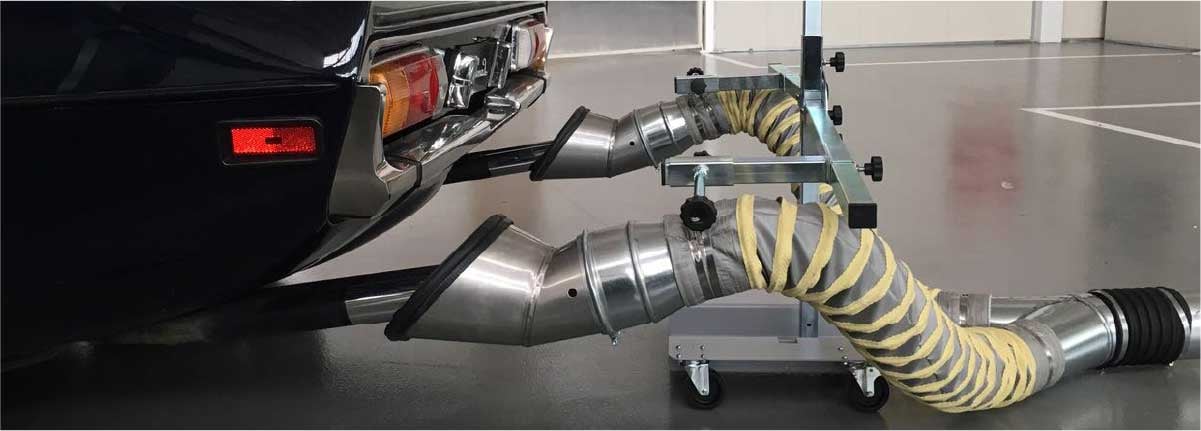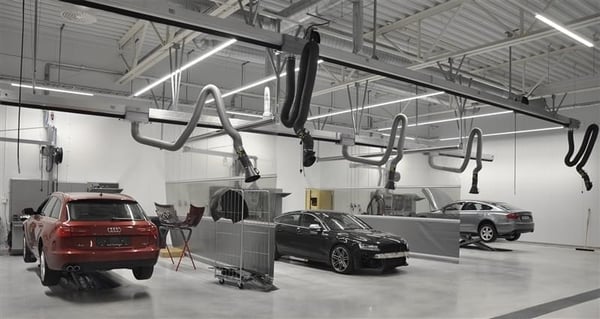 When it comes to running an Automotive workshop, it is essential to ensure the safety and health of employees and the quality of services offered to customers. That is why installing a state-of-the-art exhaust gas extraction system can make all the difference.
When it comes to running an Automotive workshop, it is essential to ensure the safety and health of employees and the quality of services offered to customers. That is why installing a state-of-the-art exhaust gas extraction system can make all the difference.
In today's article, we give you 8 tips for choosing the best system for your workshop: read on!
Looking for vehicle exhaust extraction systems?
Exhaust gases contain a number of harmful substances, including carbon monoxide, nitrogen oxide and particulate matter. Long-term exposure to these pollutants can cause serious health problems, including respiratory and cardiovascular diseases and even cancer. An effective extraction system is therefore essential to protect the health of employees and maintain a safe working environment.
Here are some considerations to take in mind before choosing an exhaust gas extraction system.
1. Evaluation of the specific needs of the workshop
Every workshop is unique and the exhaust extraction system requirements can differ from one environment to another. Before purchasing an exhaust extraction system, take the time to evaluate the specific needs of your workshop.
2. The size of the workshop
The size of the workshop will influence the necessary power and capacity of the exhaust extraction system. Larger workshops will require more powerful systems to ensure complete coverage.
An oversized system will only result in a enormous waste of resources; on the other hand, an undersized system will not be able to guarantee a healthy working environment.
3. Calculates the volume of vehicles in the workshop
How many cars does an average workshop work on daily? A larger number of vehicles requires a more robust and well-designed system to ensure a safe and compliant working environment. It is also important to consider peak loads and ensure that the system can handle them without compromising efficiency.
4. The types of vehicles that require assistance
The type of vehicle has a major influence on the choice of system. The size, configuration and quantity of fumes emitted can vary greatly depending on cars, vans, light and heavy trucks and require more powerful systems. Therefore, the exhaust system must be designed to cope with the specific emissions of each vehicle type, including possible exhaust gas treatment technologies.

5. Learn about safety regulations
Checking local laws and safety regulations relating to exhaust gas extraction is a crucial step when choosing and installing an extraction system in a car workshop. Local and national laws and regulations in fact lay down specific rules for exhaust gas extraction and work safety in car workshops.
Compliance with these regulations is essential to avoid legal problems and financial penalties.
6. Explore the different exhaust systems options
Once defined the specific needs of your workshop, it is time to explore the different exhaust system options available on the market. The most common include:
- fixed systems which consist of a reel or miniset (fan, pipe and nozzle) and include a galvanised pipe that transports the gases outside.
- underfloor systems are developed precisely below the floor and are practically invisible once underground. This is the solution that can only be implemented on new buildings or when it is not possible to attach to the ceiling.
- sliding systems consist of an aluminium suction channel on which the hose carts, reels or innovative touchless arms slide.
- stand-alone systems are portable vacuum cleaners that do not require installation and are easily transportable from one area to another thanks to their wheels. They are the ideal solution for small workshops, where the installation of a roof chimney is not necessary.
7. Do not underestimate long-term costs
After evaluating the initial purchasing cost of the vehicle exhaust extraction system it’s important to assess the long-term costs. A more energy-efficient system results in lower operating and maintenance costs. Furthermore, by meeting energy efficiency criteria, a company can benefit from tax incentives or government subsidies, which further reduce the total cost of ownership of the system. It should also be considered that an efficient exhaust extraction system contributes to a healthier working environment, with consequent benefits in terms of employee health, reduced absenteeism, and increased productivity, all of which translate into economic benefits for the company.
8. Seek advice from professionals
Finally, it is always advisable to consult professionals in the field for advice and recommendations. An expert in exhaust gas extraction systems can help you assess your specific needs and find the best solution for your workshop, as well as offer assistance in designing and installing the system. Investing in the right solution today can lead to significant benefits in the future, including increased increased productivity greater workplace safety and a better reputation among customers.
Choosing vehicle exhaust extraction systems for a car workshop is a crucial step in ensuring a safe working environment and regulatory compliance. It is right to take the time to carefully assess the specific needs of the workplace, explore the different options available and consider the long-term costs. Ensuring the health and safety of employees is a key priority, as well as legally obligatory for the employer, so it is crucial not to take this decision lightly.
If you are looking for an exhaust gas extraction system for your workshop and want to resolve your doubts, the experts WORKY are at your disposal! Book a free, no-obligation consultation.



